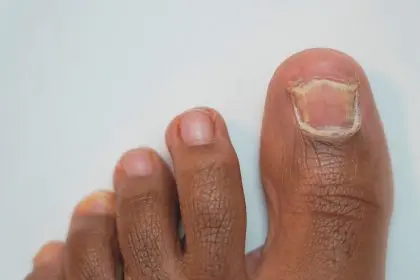You’ve nailed your skincare routine. Cleanser, serum, moisturizer, sunscreen — check, check, check, check. You’ve even cut back on sugar and alcohol to keep premature aging at bay. But what if the air inside your home is secretly sabotaging all your efforts?
While we’ve long known about the skin-damaging effects of outdoor pollution, the air quality inside our homes has flown under the radar. Yet the average American spends about 90% of their time indoors, breathing air that can contain two to five times more pollutants than outdoor air, according to EPA estimates. Your skin serves as the first line of defense against these invisible aggressors, often paying a hefty price in the process.
Let’s pull back the curtain on how your indoor environment might be accelerating your skin’s aging clock, and what you can do to turn back time.
The particulate matter quietly aging your skin
Those tiny, invisible particles floating around your home pack a powerful aging punch. PM2.5 — particulate matter smaller than 2.5 micrometers — easily penetrates your skin barrier, triggering inflammation and oxidative stress at the cellular level. These microscopic invaders come from cooking, especially frying and high-heat methods, candle burning, and even your gas stove.
What makes these particles especially damaging is their size. At less than one-thirtieth the width of a human hair, they’re small enough to slip past your skin’s protective barrier and wreak havoc on the deeper layers where collagen and elastin live. The inflammatory response they trigger accelerates the breakdown of these essential proteins, leading to premature sagging and wrinkle formation.
Even more concerning, research shows these particles continue damaging skin cells long after exposure. A 2021 study found that particulate matter exposure triggered a cascade of inflammatory responses that continued for up to 24 hours, meaning that brief cooking session could impact your skin’s aging process all day long.
The drying effect of indoor heating and cooling
That comfortable indoor climate control comes at a steep price for your skin. Forced air heating and air conditioning systems dramatically lower indoor humidity levels, sometimes creating desert-like conditions inside your home. When ambient humidity drops below 40%, your skin starts losing moisture to the air around you through a process called transepidermal water loss.
This chronic low-humidity environment forces your skin into a constant state of repair, diverting energy away from normal functions like collagen production. The resulting dehydration makes fine lines more visible in the short term while accelerating their formation over time. Even worse, dehydrated skin becomes more permeable, allowing more pollutants to penetrate and cause damage.
Age plays a cruel role in this process too. As we get older, our skin naturally produces less sebum, making us more vulnerable to environmental moisture loss. This explains why mature skin often shows more dramatic effects from indoor climate control, with increased dryness, flaking, and pronounced fine lines during heating season.
The skin-destroying power of volatile organic compounds
That fresh paint smell? The lemony scent of your cleaning products? The comforting aroma of your scented candles? All likely contain volatile organic compounds, or VOCs — airborne chemicals that silently wage war on your skin’s collagen supply.
VOCs work their damaging magic through oxidative stress, essentially creating an internal rust that breaks down cellular structures. They’re particularly effective at depleting antioxidant levels in the skin, leaving it vulnerable to further damage. A 2020 dermatology study found that participants living in environments with higher VOC concentrations showed measurably more severe signs of aging, including increased wrinkle depth and reduced skin elasticity.
The most common indoor sources include air fresheners, scented personal care products, new furniture, carpeting, paint, and ironically enough, many “clean” household products. What makes VOCs particularly problematic is their longevity in indoor environments, where they can linger for weeks or months, creating chronic exposure that amplifies their aging effects.
The unexpected skin impact of blue light inside your home
We’ve heard plenty about the blue light emitted by our devices, but less discussed is how indoor lighting choices affect skin aging. Many energy-efficient LED bulbs emit high levels of blue light, which penetrates deeper into the skin than UVA rays. This exposure triggers a process called photoaging, producing effects similar to sun damage but from sources we’re exposed to for far longer periods.
Blue light disrupts your skin’s natural repair cycle by damaging mitochondria, the cellular powerhouses responsible for energy production. When these critical structures become impaired, cells can’t effectively repair daily damage, leading to accelerated aging. Research also suggests blue light exposure can trigger hyperpigmentation, particularly in darker skin tones, leading to uneven skin tone and age spots.
What makes indoor blue light exposure particularly insidious is its ubiquity. From smartphones to computers to overhead lighting, we bathe in this skin-aging wavelength from morning until night, rarely giving our skin a chance to recover from its damaging effects.
The skin barrier breakdown from low humidity
Beyond just causing dryness, consistently low indoor humidity actively damages your skin’s protective barrier function. This critical lipid layer acts as your skin’s security system, keeping irritants out and moisture in. When compromised by dry indoor air, this barrier becomes less effective at both jobs.
The resulting microcracks in the skin surface aren’t just a cosmetic concern. They create entry points for pollutants and irritants while accelerating moisture loss, setting up a perfect storm for premature aging. Even worse, a compromised barrier triggers inflammation as your skin attempts to repair itself, leading to collagen degradation and accelerated aging.
This barrier disruption explains why skin often looks older during winter months when heating systems are running constantly. The combination of low humidity and barrier impairment creates visible aging changes that can take months to reverse, even with diligent skincare.
The mold lurking in damp areas
While much attention goes to dry air, excessive moisture brings its own skin-aging problems. Hidden mold growth, often lurking in bathrooms, kitchens, and basements, releases mycotoxins that trigger system-wide inflammation, with skin taking a significant hit in the process.
These fungal byproducts are particularly effective at triggering a type of cell damage called oxidative stress, which accelerates the breakdown of collagen and elastin. A 2019 immunology study found that exposure to even low levels of certain mycotoxins increased markers of skin aging by up to 60% compared to control groups.
What makes mold especially problematic for skin health is its persistent nature. Once established, mold colonies continue releasing damaging compounds indefinitely, creating chronic inflammation that accumulates over time. Those living in water-damaged buildings often show signs of premature aging that don’t respond to typical skincare interventions, highlighting the powerful impact of this hidden indoor pollutant.
The CO2 buildup affecting cellular renewal
The simple act of breathing gradually increases carbon dioxide levels in poorly ventilated homes, with surprising consequences for skin aging. In sealed environments like energy-efficient homes or offices, CO2 concentrations can reach levels that impair cellular metabolism, slowing the skin renewal processes that keep us looking youthful.
Elevated indoor CO2 has been shown to reduce mitochondrial function in skin cells, essentially putting them into a state of hibernation where repair and regeneration slow dramatically. This reduced cellular activity means damaged skin takes longer to heal, collagen production decreases, and the visible signs of aging accumulate more rapidly.
The effect becomes more pronounced in bedrooms overnight, where CO2 levels in closed rooms can rise significantly during sleep. This explains why skin sometimes appears more aged after sleep in stuffy bedrooms, despite sleep normally being prime repair time for skin cells.
Your home environment plays a far bigger role in your skin’s aging process than most people realize. The good news is that understanding these indoor air quality factors gives you powerful tools to create a more skin-friendly space. Simple changes like improving ventilation, filtering air, maintaining optimal humidity, and reducing chemical use can dramatically slow the indoor aging process.
While you can’t stop time completely, you can certainly change how quickly it shows up on your face. By addressing these hidden aging accelerators, your skin gets the chance to age at its natural pace rather than on the artificially accelerated timeline created by poor indoor air quality. Your best anti-aging strategy might not be another expensive cream, but simply cleaning up the air around you.















